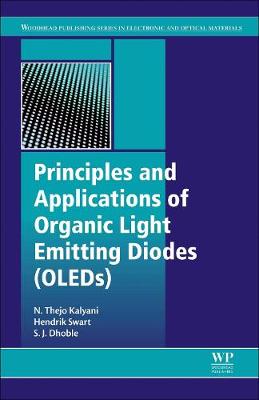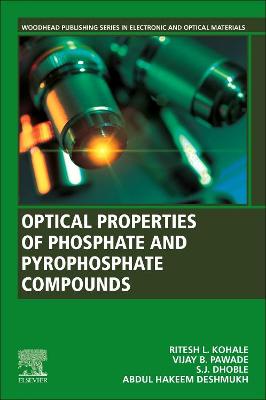Woodhead Publishing Series in Electronic and Optical Materials
5 total works
Principles and Applications of Organic Light Emitting Diodes (OLEDs)
by N. Thejo Kalyani, Hendrik C. Swart, and Sanjay J. Dhoble
Published 18 May 2017
Principles and Applications of Organic Light Emitting Diodes (OLEDs)explores the ways in which the development of organic semiconductor materials is opening up new applications in electronic and optoelectronic luminescent devices.
The book begins by covering the principles of luminescence and the luminescent properties of organic semiconductors. It then covers the development of luminescent materials for OLEDs, discussing the advantages and disadvantages of organic versus inorganic luminescent materials. The fabrication and characterization of OLEDs is also covered in detail, including information on, and comparisons of, vacuum deposition and solution techniques.
Finally, applications of OLEDs are explored, including OLEDs in solid-state lighting, colored lighting, displays and potential future applications, such as ultra-thin and flexible technologies.
This book is an excellent resource both for experts and newcomers to the field of organic optoelectronics and OLEDs. It is ideal for scientists working on optical devices, lighting, display and imaging technologies, and for all those engaged in research in photonics, luminescence and optical materials.
The book begins by covering the principles of luminescence and the luminescent properties of organic semiconductors. It then covers the development of luminescent materials for OLEDs, discussing the advantages and disadvantages of organic versus inorganic luminescent materials. The fabrication and characterization of OLEDs is also covered in detail, including information on, and comparisons of, vacuum deposition and solution techniques.
Finally, applications of OLEDs are explored, including OLEDs in solid-state lighting, colored lighting, displays and potential future applications, such as ultra-thin and flexible technologies.
This book is an excellent resource both for experts and newcomers to the field of organic optoelectronics and OLEDs. It is ideal for scientists working on optical devices, lighting, display and imaging technologies, and for all those engaged in research in photonics, luminescence and optical materials.
The Fundamentals and Applications of Light-Emitting Diodes
by Sanjay J. Dhoble and Govind B. Nair
Published 9 July 2020
The Fundamentals and Applications of Light-Emitting Diodes: The Revolution in the Lighting Industry examines the evolution of LEDs, including a review of the luminescence process and background on solid state lighting. The book emphasizes phosphor-converted LEDs that are based on inorganic phosphors but explores different types of LEDs based on inorganic, organic, quantum dots, perovskite-structured materials, and biomaterials. A detailed description is included about the diverse applications of LEDs in fields such as lighting, displays, horticulture, biomedicine, and digital communication, as well as challenges that must be solved before using LEDs in commercial applications.
Traditional light sources are fast being replaced by light-emitting diodes (LEDs). The fourth generation of lighting is completely dominated by LED luminaires. Apart from lighting, LEDs have extended their hold on other fields, such as digital communications, horticulture, medicine, space research, art and culture, display devices, and entertainment. The technological promises offered by LEDs have elevated them as front-runners in the lighting industry.
Traditional light sources are fast being replaced by light-emitting diodes (LEDs). The fourth generation of lighting is completely dominated by LED luminaires. Apart from lighting, LEDs have extended their hold on other fields, such as digital communications, horticulture, medicine, space research, art and culture, display devices, and entertainment. The technological promises offered by LEDs have elevated them as front-runners in the lighting industry.
Optical Properties of Phosphate and Pyrophosphate Compounds
by Ritesh L. Kohale, Vijay B. Pawade, Sanjay J. Dhoble, and Abdul Hakeem Deshmukh
Published 11 December 2020
An in-depth look at the luminescence of phosphor materials for applications in optical devices, sensors, and medical technologies.
Optical Properties of Phosphate and Pyrophosphate Compounds gives a broad introduction to pyrophosphates and phosphate-based phosphors, including their fundamental properties, material composition, synthesis methods, characterization techniques, and applications in optical devices and technologies. The text describes the development of the materials’ shape and size, as well as crucial characterization techniques for key applications. Additionally, it includes essential information about recently used single and mixed cations pyrophosphate and phosphate compounds.
This book is suitable for researchers working in materials science, engineering, materials chemistry, and physics. It may also be helpful to engineers and chemists working in R&D for solid state lighting.
Optical Properties of Phosphate and Pyrophosphate Compounds gives a broad introduction to pyrophosphates and phosphate-based phosphors, including their fundamental properties, material composition, synthesis methods, characterization techniques, and applications in optical devices and technologies. The text describes the development of the materials’ shape and size, as well as crucial characterization techniques for key applications. Additionally, it includes essential information about recently used single and mixed cations pyrophosphate and phosphate compounds.
This book is suitable for researchers working in materials science, engineering, materials chemistry, and physics. It may also be helpful to engineers and chemists working in R&D for solid state lighting.
Green-Emitting Luminescent Materials
by Vishal R Panse, Sanjay J. Dhoble, and Marta Michalska Domanska
Published 1 December 2022
Green-Emitting Luminescent Materials: Phosphor Materials, Properties, Synthesis, and Characterization summarizes the present knowledge on the use, advances, advantages and weaknesses of a large number of experimental techniques that are available for the characterization of inorganic green emitting phosphors. Different characterization techniques with spectroscopy are classified according to the group of the technique used, the information they can provide, or the materials that they are used to observe. The authors describe the main characteristics of the techniques and their operation principles and give various examples of their use, presenting them in comparison with one another.
This book is suitable for researchers and practitioners in academia, research and development in the disciplines of materials science and engineering, chemistry and physics.
This book is suitable for researchers and practitioners in academia, research and development in the disciplines of materials science and engineering, chemistry and physics.
Lanthanide-Doped Aluminate Phosphors
by Atul Yerpude, Vijay B. Pawade, Sanjay J. Dhoble, and Lehlohonolo Fortune Koao
Published 1 January 2023
Lanthanide Doped Aluminate Phosphors: Synthesis, Properties, and Applications is an overview of the advances of research on aluminate-based long persistent phosphors and their applications in lighting, display, radiation dosimetry, and imaging. The book reviews the most important categories of rare earth aluminate-based phosphors including aluminosilicates and aluminoborates. This category of material is attractive for a wide range of applications because of their high quantum efficiency, long afterglow life, chemical stability and optical properties, which is discussed throughout. Optical properties, in particular, are emphasized in the book along with the relationship of the chemical composition and doping of these materials and their optical performance.
Lanthanide Doped Aluminate Phosphors: Synthesis, Properties, and Applications is suitable for researchers and practitioners working in academia and research and development in industry in the disciplines of materials science and engineering, chemistry and physics.
Lanthanide Doped Aluminate Phosphors: Synthesis, Properties, and Applications is suitable for researchers and practitioners working in academia and research and development in industry in the disciplines of materials science and engineering, chemistry and physics.




